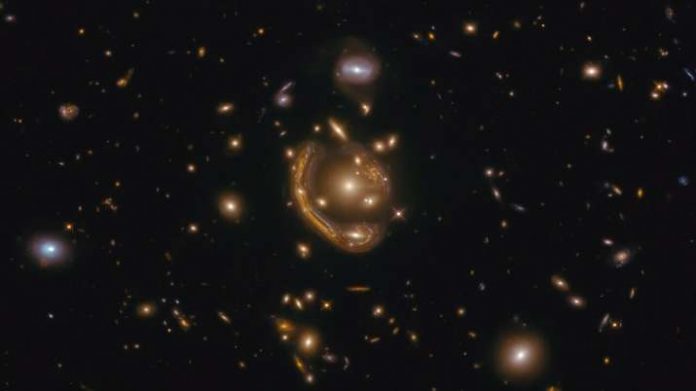The Hubble Space Telescope, an international cooperation between NASA and the ESA (European Space Agency), in December 2020 released a photo a striking example of a deep-space optical phenomenon dubbed an “Einstein ring”. The observation sparked new research.
This Hubble picture exemplifies the fact that the universe is a vast stage for grand illusions. Albert Einstein realized this a century ago as he formulated his law of general relativity. Gravity, he said, warped space like stretching and twisting a rubber sheet. The consequences would be that images of distant objects would be magnified, brightened, and distorted into funhouse mirror views. This is because their light would be bent as it traveled across the invisible tapestry of space and occasionally passed through gravitational “potholes” formed by massing objects that got in the way of the light path to Earth. However, Einstein knew that seeing such illusions would require much more powerful future telescopes. Little might he have imagined Hubble’s treasure trove!
Hubble was used to take a look at one of the most stunning manifestations of a so-called Einstein ring: a donut-like loop of light that is as eerie as it is striking. The object seen here is cataloged as GAL-CLUS-022058s. It is located in the southern hemisphere constellation of Fornax (the Furnace). The image was nicknamed the “Molten Ring.”
The lensing effect, caused the gravity of an intervening foreground object, creates multiple images of the contents of the more distant galaxy, that are magnified and smeared into an arc. The galaxy is so far away, we see it as it looked over 9 billion years ago, when the universe was less than half its present age. This was a time when the universe was going through a “baby boom,” forming thousands of stars at a prolific rate. The magnified image of the galaxy gives astronomers a close-up glimpse into the distant past.
Hubble Space Telescope’s glamour shots of the universe are so revealing they nearly always have a discovery behind them.
In this particular snapshot, a science discovery followed the release of a Hubble observation of a striking example of a deep-space optical phenomenon dubbed an “Einstein ring.” The photo was released in December 2020 as an example of one of the largest, nearly complete Einstein rings ever seen.
In this image, a remote galaxy is greatly magnified and distorted by the effects of gravitationally warped space. After its public release, astronomers used the picture to measure the galaxy’s distance of 9.4 billion light-years. This places the galaxy at the peak epoch of star formation in cosmic evolution.
The extremely high rate of star formation in the brightest and very dusty early galaxies saw stars being born at a rate a thousand times faster than occurs within our own galaxy. This could help explain the rapid build-up of present day giant elliptical galaxies.
This object’s unusual partial ring-like appearance can be explained by a phenomenon called gravitational lensing, which causes light shining from a faraway galaxy to be warped by the gravity of an object between its source and the observer. This effect was first theorized by Albert Einstein in 1912, and later worked into his theory of general relativity.
In this case, the galaxy’s light has also been magnified by a factor of 20. This magnification, boosted by mother nature, effectively made Hubble’s observing capability equivalent to that of a 48-meter-aperture telescope. The lensing effects also create multiple apparitions around the curved arc of the single background magnified galaxy.
In order to derive the physical properties of the galaxy, astronomers had to precisely model the effects of the lensing on the galaxy’s image. “Such a model could only be obtained with the Hubble imaging,” explained the lead investigator Anastasio Díaz-Sánchez of the Universidad Politécnica de Cartagena in Spain. “In particular, Hubble helped us to identify the four duplicated images and the stellar clumps of the lensed galaxy.”
The initial Hubble observation was first conducted by Saurabh Jha of Rutgers, The State University of New Jersey. His team’s science goal was to use Hubble’s sharp image to reveal detailed complex structure in the ring arcs.
The object, GAL-CLUS-022058s, is located in the southern hemisphere constellation of Fornax (the Furnace). The image was nicknamed the “Molten Ring” by Jha, which alludes to its appearance and host constellation.















